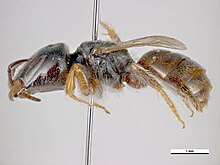Lasioglossum hemichalceum
| Lasioglossum hemichalceum | |
|---|---|
 |
|
| L. hemichalceum | |
| Scientific classification | |
| Kingdom: | Animalia |
| Phylum: | Arthropoda |
| Class: | Insecta |
| Order: | Hymenoptera |
| Superfamily: | Apoidea |
| Family: | Halictidae |
| Subfamily: | Halictinae |
| Genus: | Lasioglossum |
| Species: | L. hemichalceum |
| Binomial name | |
|
Lasioglossum hemichalceum (Cockerell, 1923) |
|
Lasioglossum hemichalceum, otherwise known as L. erythrurum, is a sweat bee that is known to occupy certain regions of Australia. Large numbers of unrelated female members will typically share a single nest. Unlike other bees, these nests are constructed underground by the independent efforts of the females.L. hemichalceum will typically begin creating new colonies during the summer, and will conduct brood production in late November through the first few months of spring. The genetic relatedness of L. hemichalceum members varies depending on the members' relationships with one another. Unlike other species of bees, the members of this species do not demonstrate aggressive behavior towards one another. In addition, an interesting fact about L. hemichalceum is that as the size of the colony increases, the reproductive potential of each female does not change. This is different from other species of bees.
The Lasioglossum hemichalceum is part of the genus Lasioglossum. The two species that are most closely related to L. hemichalceum are the Lasioglossum florale and Lasioglossum lanarium. Other species within this genus include Lasioglossum malachrum, Lasioglossum zephyrum and Lasioglossum clarum. The next most closely related species is the Lasioglossum zonulum. Unlike some species within the Halictidae family, this particular genus is characterized by very fragile wings, which can sometimes inhibit the L. hemichalceum from flying, and have small veins near the outer portions of the wings.Lasioglossum species which occupy parts of Africa and central Europe demonstrate varying types of social behavior—ranging from solitary to communal and even semi-social. Variability in sociality is correlated with both the altitude and latitude that the bees occupy. As altitude and latitude increase, the amount of solitary behavior also increases. The L. hemichalceum is in the company of nearly 350 other species that fall within the genus of Lasioglossum and are also native to Australia. However, the greatest amount of variability among bees within this subfamily of halictinae is seen in Africa and Madagascar.
Lasioglossum hemichalceum can be identified by its medium long antennas, often off-white in color, and triangular head. While many are dull black in color, there are also members that can be various shades of purple, green, or copper. Males typically have thinner bodies than females and also have less hair on their hind legs for carrying pollen. Females usually range from 4.7–5 mm in length, and have wider heads than males (being about 1.5-1.6 mm in width). Male members have slightly shorter body lengths, and heads that are more narrow in length (approximately 3.8-4.7 mm in length, and 1.3-1.5 mm in width). In addition, the legs of the L. hemichalceum tend to be dark brown or black in color, although there have been instances of red-brown pigmentation. In terms of coloring, there are not significant differences between female and male members. Furthermore, because the L. hemichalceum is a communal species, there are not queens who are distinguishable from workers—almost all members appear the same in appearance.
...
Wikipedia
